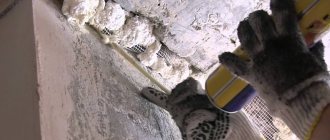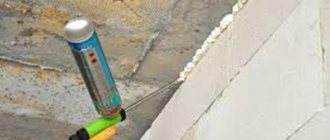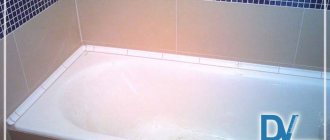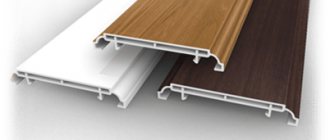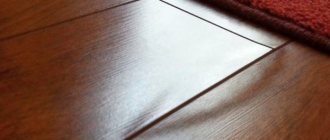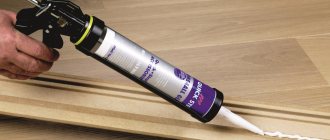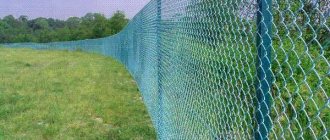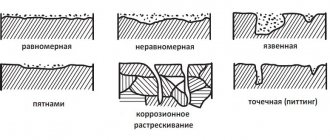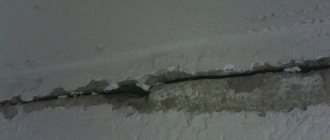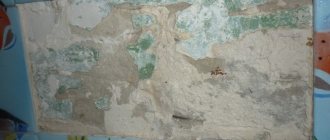Sealing window cracks is carried out using different methods and materials. For this purpose, sealants, putties, plasters, and special putties can be used. The specific choice depends on the type of gap, its location, and size.
Source spravochnika.ru
Silicone sealant
Manufactured on the basis of organosilicon silicone polymer. The composition is well applied to the surface, elastic, and has good adhesive properties. In terms of performance characteristics, it is considered one of the best materials intended for sealing cracks in windows. Can be used indoors and outdoors.
Source a-mortar.ru
Among the wide list of advantages of silicone sealants, in my opinion, are the following characteristics:
- Absolutely waterproof. The structure of the material does not collapse under prolonged exposure to precipitation.
- Resistance to solar ultraviolet rays.
- Preservation of plasticity and elastic properties. After hardening, silicone retains its properties. The layer expands and contracts depending on temperature changes.
- Immunity to aggressive biological species. The composition is not prone to the formation of fungi and molds.
- Excellent adhesive properties. Silicone adheres well to different types of building materials: stone, brick, wood, concrete, plastic.
- A wide palette of colors makes it easy to choose the shade of a wooden or PVC window.
Source: buffersystemshop.ru
When working with silicone sealant for windows inside, I always ventilate the room. The reason is that the composition smells unpleasant when not frozen.
Slope insulation
Slopes need to be insulated when there are cracks that allow air and moisture to pass through. The material used for these purposes is one that is easy to install, durable and safe. Ordinary polystyrene foam has these properties. It is one of the simplest and most convenient hydro- and heat-insulating materials.
The process of insulating a slope with foam plastic looks like this:
- Treating the entire surface of the slope with an antiseptic primer, removing excess foam.
- Apply plaster mortar to the slope using a special spatula, leveling the surface with a trowel.
- Re-treat the surface with a primer after the plaster layer has completely dried.
- Cutting out pieces of foam plastic and sanding them.
- Spreading foam with glue and attaching it to the surface.
- Processing foam plastic with plaster.
- Applying primer to a dry surface.
Insulating slopes yourself is not difficult if you purchase good quality materials and find out in advance in what order the work should be performed. As a result of high-quality sealing, cold air will not flow through the window opening, which means the room will become more comfortable to live in.
Acrylic
I should immediately note that I do not like this composition due to its minimal elasticity. Within 1-2 years, a seam sealed with acrylic sealant looks excellent. After this period, microcracks form again, which require another intervention.
Briefly about the characteristics and main features of the material, we can say the following:
- Has the lowest price.
- It adheres well to all types of surfaces: glass, wood, plastic, stone.
- Unlike silicone ones, it is easy to paint. Therefore, there is no need to pre-select the appropriate shade.
- Does not smell and is absolutely safe for use indoors and outdoors.
Source images.ru.prom
The disadvantages of acrylic window sealants include low ductility and a high probability of cracking as a result of exposure to negative temperatures, which can lead to depressurization of the window.
In addition to the likelihood of cracking, acrylic compositions have significant shrinkage. Therefore, to obtain a smooth surface, you will need to carry out 2-3 applications.
Preventive inspection of windows against drafts
First of all, you need to check the condition of the window seals and where exactly they allow air to pass through. The easiest way to do this is in cold windy weather with a burning candle. If the fire fluctuates, it means the seal is broken.
Another option is to place a sheet of paper in the open window. Then close the sash and try to pull it out. If this is possible, the seal needs to be replaced. The domestic market offers products made from ethylene propylene rubber, silicone, rubber, and thermoplastic elastomer. The cost of 1 linear meter ranges from 30 to 55 rubles.
Thiokol
A material whose performance characteristics are in no way inferior to silicone sealant. Thiokol (polysulfide) compositions are based on liquid thiokol, the structure of which resembles liquid rubber. Of the most significant advantages, I will note the following qualities:
Maintains elasticity after hardening.
Immunity to oil, gasoline.
Resistance to ultraviolet radiation and sudden temperature changes.
Source st26.stpulscen.ru
Despite all the advantages of polysulfide sealants, I do not use them in my work for the following reasons:
- Incompatibility with PVC materials. The sealant contains solvents that have a negative effect upon prolonged contact with plastic.
- It is sold in buckets, in large volumes, which is not very convenient for processing window cracks, where a minimum amount of material is required.
- The composition is two-component. Therefore, it is quite difficult to predict the exact amount that will be needed to process several seams.
- The viability of the diluted composition is no more than 2-3 hours. After this period, the material simply loses its original qualities.
Thiokol sealants are excellent for sealing gaps created by installing wooden windows. They are incompatible with plastic double-glazed windows.
Sealing a plastic window with your own hands
Treating the window opening with sealant is the final stage of installing a double-glazed window. Sealing is carried out when all installation work has already been completed, and consists of several stages:
- Installation of double-glazed windows. First, the junction seam, which is the gap between the frame and the opening, is filled with polyurethane foam. You need to wait until it dries completely so that it fills all the small irregularities and holes.
- Finishing. Then you need to cut off the protruding part of the foam and treat the outside of the seam with cement mortar.
- Sealing. Mounting sealant is applied only on the outside. You need to apply it around the entire perimeter of the seam and wait until it dries completely.
Proper sealing of a plastic window with your own hands begins with removing excess polyurethane foam. If this is not done, the seams will look uneven and the sealing will not be of very high quality. Plastering is also mandatory. The solution is applied to the joint. This will provide additional protection for the polyurethane foam. For additional insulation, it is better to lay polyurethane sealing tape around the outer perimeter before applying the sealant. If there is a strong gap between the frame and the opening, you can lay the tape directly to the wall.
Rice. 2. Sealing window seams
Polyurethane
A polyurethane-based composition is an excellent sealant that can be used to seal seams formed after the installation of plastic or wooden windows. Of the most significant operational characteristics, I would like to note the following:
- Increased elasticity. For some manufacturers it can reach 100%. This facilitates ease of application and distribution inside cracks.
- The composition adheres well to most building materials. Including old sealing compounds.
- Polyurethane sealant is not afraid of moisture, sudden temperature changes, and direct sunlight.
- The composition does not form smudges when applied.
- It is sold in a tube to fit a classic air gun, which makes it easier to work with.
- Virtually no shrinkage. Therefore, it can be applied in 1 layer.
- By analogy with silicone composition, polyurethane sealant is available in a wide range of colors and shades.
- The composition is absolutely environmentally friendly, allowing it to be used both indoors and outdoors.
Source vannajainfo.ru
Separately, I would like to note one feature that is not characteristic of other similar materials. This composition retains its performance properties even when applied in the cold season. To work with it, it is enough to keep the tube at room temperature for 10-12 hours.
Polyurethane sealant is presented by the manufacturer in two versions:
As a one-component, ready-made composition, sold in the above-mentioned tubes.
In the form of two-component compositions, where the hardener is added to the base mass immediately before application.
In this case, I described the advantages of one-component compositions, since I do not like working with two-component ones for the reasons listed above.
30 mobile workshops in Moscow and the region
Today
Ivan Gubik is working,
master expert, 12 years in the company
- Completed training and internship
- Manufacturer certified
- Completed customer service courses
Ruslan Kovalenko,
master expert, 8 years in the company
- Completed training and internship
- Manufacturer certified
- Completed customer service courses
Sergey Sultan,
master expert, 9 years in the company
- Completed training and internship
- Manufacturer certified
- Completed customer service courses
Victor Gazul,
master expert, 3 years in the company
- Completed training and internship
- Manufacturer certified
- Completed customer service courses
Igor Gerasimenko,
master expert, 5 years in the company
- Completed training and internship
- Manufacturer certified
- Completed customer service courses
Boris Egorov,
master expert, 2 years in the company
- Completed training and internship
- Manufacturer certified
- Completed customer service courses
Yuri Mark,
master expert, 4 years in the company
- Completed training and internship
- Manufacturer certified
- Completed customer service courses
Alexey Trofimenko,
master expert, 4 years in the company
- Completed training and internship
- Manufacturer certified
- Completed customer service courses
Alexander Loginov,
master expert, 2 years in the company
- Completed training and internship
- Manufacturer certified
- Completed customer service courses
Dmitry Babiy,
master expert, 3 years in the company
- Completed training and internship
- Manufacturer certified
- Completed customer service courses
Alexander Vaskin,
master expert, 5 years in the company
- Completed training and internship
- Manufacturer certified
- Completed customer service courses
Roman Kozhan,
manager, 1 year in the company
- Completed training and internship
- Manufacturer certified
- Completed customer service courses
Victor Komarov,
master expert, 7 years in the company
- Completed training and internship
- Manufacturer certified
- Completed customer service courses
Sergey Kudryashov,
master expert, 3 years in the company
- Completed training and internship
- Manufacturer certified
- Completed customer service courses
Vitaly Savka,
master expert, 3 years in the company
- Completed training and internship
- Manufacturer certified
- Completed customer service courses
Liquid plastic
At this point I would like to talk about two products called “Cosmofen”.
- COSMOFEN PLUS – for sealing joints no more than 2 mm wide.
- COSMOFEN 345 – for sealing joints with a width of no more than 7 mm.
These are compositions unique in their characteristics, designed for gluing structures using “diffusion welding”. After application, the composition penetrates into the surface structure, and when hardened, it forms a single monolithic composition with them.
Source krepeg-tula.ru
For those who decide to give preference to Cosmofen, I would like to recommend that you read the instructions for use more carefully and will once again emphasize a number of features that distinguish it from other analogues. They are as follows:
- Cosmofen does not need to be smoothed or rubbed in after application. By doing this, you simply disrupt the aforementioned penetration process, which begins due to the rapid evaporation of air particles. Remember, by smoothing it you make the final layer thinner and destroy the film that forms on it.
- There is no need to wet the surface before applying Cosmofen. The reason is similar to that described earlier: upon contact with a wet surface, the top layer is destroyed. This reduces the quality of the applied coating, quickly loses its appearance and begins the process of destruction (cracking).
Source vseinstrumenti.ru
Why is it needed?
After installing new glass blocks, be sure to seal the internal and external seams. Due to air gaps, heat escapes from the room, so the room needs to be heated more. During the heating season, losses increase bills, which negatively affects the family budget.
High-quality insulation of windows occurs at the installation stage. Professional sealing of double-glazed windows consists of 3 layers:
- Basic. The center of the structure is foamed with building mass. Polyurethane quickly degrades, so it must be hidden from ultraviolet radiation and temperature changes.
- External. Waterproofing windows protects against moisture from the street. Additionally, it insulates the opening and protects the foam from UV radiation. The outer layer has one-sided permeability, which improves the ventilation of the seam, preventing the appearance of mold.
- Interior. The vapor barrier is located on the side of the room. The element prevents moisture from entering the assembly seam. Due to the structural features, the liquid does not linger on the surface and dries quickly.
Window sealing does not function correctly if the technology is violated. If installers are too lazy to make the outer or inner layer, then the integrity of the system is destroyed. It will blow from the cracks, and condensation from the glass will accumulate, forming puddles on the windowsill. In severe frosts, the seam freezes, which leads to damage to the insulation and polyurethane foam.
Plaster
Sealing external seams after installing plastic windows using the plastering method also requires compliance with certain rules. First of all, this relates to the choice of material suitable for these purposes. The most convenient to use is elastic acrylic plaster. The only thing I want to warn you about is: before purchasing, pay attention to the manufacturer’s recommended thickness of the seam to be applied. There are compositions intended strictly for decorative work and they are laid in a thin layer (5-10 mm).
If it is necessary to seal a seam whose depth is 3 centimeters or more, I recommend using proven cement-based plaster. It can be used for sealing deep seams.
Source usetips.ru
Reasons for the formation of cracks
The first sign of increasing cracks is dust on the windowsill, which appears a short time after erasing. Also, a violation of the tightness is indicated by fogging of glass, drafts and noise. The biggest problem is the appearance of drips on the wallpaper under the windowsill and mold.
To seal cracks, it is important to find out the reason for their appearance:
- Violation of installation rules . Unprofessional installation leaves large, poorly foamed gaps between the wall and the glass unit. The installation material dries out over time, causing the window to warp and cracks to form. A candle will help check the tightness. Pass the flame of a candle or lighter along the joints. The external contact areas of the frame must be tightly foamed, puttied and plastered.
- Seal wear . The rubber bands can crack, jump out of the groove and tear. Untreated material is destroyed by sun, snow and rain. It is important to apply a coat of plaster or paint on the street side to protect the seal.
- Wear of fittings . Natural wooden frames are susceptible to adverse environmental influences. The wood dries out during use and the cracks increase. In plastic structures, rubber seals, locks and latches become unusable.
Requirements for translucent structures of residential buildings
According to the above GOST R 56926-2016, design solutions for window and balcony blocks, assemblies adjacent to external wall openings must ensure water and air tightness of the building when exposed to precipitation and wind, as well as combinations of these loads.
Translucent structures must provide natural lighting of the premises at a standard level (in accordance with SP 52.13330 “Natural and artificial lighting”). Therefore, the total area of light openings should be at least one-eighth of the floor area of living rooms and kitchens.
Sealing seams and joints of window systems
To prevent moisture from getting inside the room, the structures are sealed both from the inside of the room and from the facade. The following materials are applied to the frames: sealing tape, polyurethane foam, vapor-permeable tape.
When performing work on the facade side, builders adhere to the rule “the inside of the block should be denser than the outside.” The sealing tape protects the seam from precipitation and allows steam to escape rather than settle on the surface. Vapor-proof tape protects the installation seam and drainage.
Window waterproofing scheme
Preparation and application of sealing material
It doesn’t matter what grout material is chosen, in any case you need to prepare the following:
- sealant or liquid plastic;
- container with water;
- a towel or piece of fabric (rags - BUT! clean);
- degreaser;
- latex gloves (optional);
- gun.
First of all, the surface to be treated should be degreased. This must be done with a special degreaser, but alcohol can be used instead.
After the degreasing solution has dried, you can begin the process. You should put a nozzle on the tube, which will allow you to apply the mass in a thin strip or insert the cartridge into the gun, after first cutting off the tip and screwing a sharp nozzle onto it.
By the way, there are special nozzles for even application of sealant directly from the gun - HERE is a link to such an nozzle.
Slowly squeezing out the composition, it is necessary to guide the tube along the seam line or crack. You should not apply too much material, because it will become unnecessary during grouting.
Putting on a tight-fitting glove, you need to wet your index finger and walk it along the strip of sealant so that a little mass remains in the very corner and the excess is removed. Silicone (acrylic) fits tightly into the gap, but you need to carefully look to see if the window sill, slope or frame is dirty. All unnecessary drops and stains can be easily removed with the wet tip of a towel until the composition has set.

